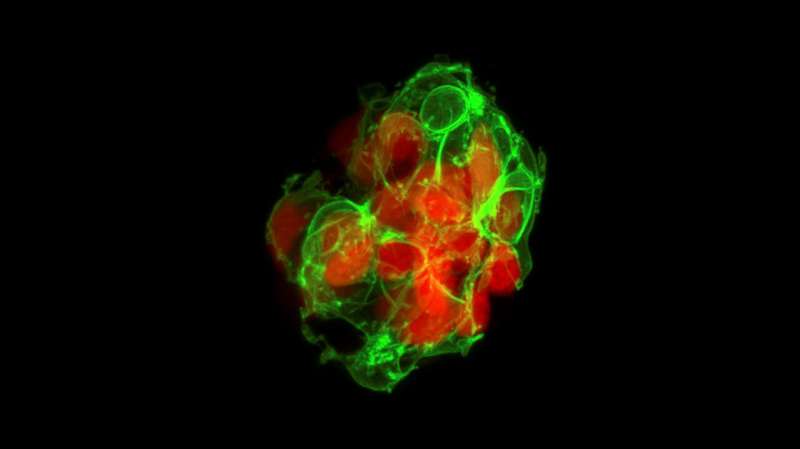This article has been reviewed according to Science X's editorial process and policies. Editors have highlighted the following attributes while ensuring the content's credibility:
fact-checked
peer-reviewed publication
trusted source
proofread
Researchers identify 'first responder' cells in pancreas crucial for blood sugar control

How does our body control blood sugar so precisely? An international team led by Prof. Nikolay Ninov at the Center for Regenerative Therapies Dresden (CRTD), part of Dresden University of Technology, brought us a step closer to the answer. They found a special group of "first responder" cells in the pancreas that are crucial for triggering blood sugar response.
Their findings were published in the journal Science Advances.
Our bodies need to keep blood sugar levels just right. Too high or too low can be dangerous. This balance is disturbed in diabetes, leading to serious health issues. Beta cells in the pancreas manage this balance by releasing insulin when blood sugar levels rise.
Understanding how beta cells work and coordinate the response to rising blood sugar can ultimately help develop better treatments for diabetes.
Not all beta cells are equal
"Looking at the pancreas, we wondered if all beta cells are actually equally sensitive to sugar. Previous studies suggested some might be more sensitive than others," says Prof. Nikolay Ninov, research group leader at the CRTD in Dresden.
To understand the work of the pancreas, the Ninov team turned to zebrafish. This small tropical fish has a pancreas that works similarly to a human one. At the same time, it offers a huge advantage. Researchers can use transparent fish that have no pigment whatsoever and observe the pancreas at work in real-time in the living fish.
The group discovered that a small group of beta cells are more sensitive to sugar levels than the others. These cells respond to glucose quicker than the rest of the cells, so the Ninov team referred to them as "first responder" cells. They initiate the glucose response, which is followed by the remaining "follower cells."
Hidden hierarchy in the pancreas
The team wanted to test if first responders are necessary for the follower cells to respond to glucose.
Using transparent fish, the Ninov group took advantage of optogenetics, a modern light-based technology that allows to turn single cells on or off with a beam of light.
Turning off the first responder cells lowered the response to the blood sugar of the follower cells. At the same time, when the first responders were selectively activated, the response of the follower cells was enhanced.
"The first responders lie at the top of the beta cell hierarchy when it comes to control of the sugar response. Interestingly, only about 10% of the beta-cells act as first responders. It suggests that this small population of cells serves as a control center for regulating the activity of the rest of the beta cells," explains Prof. Ninov.
Unique traits of first responder cells
To find out what makes the first responder cells unique, the researchers compared the gene expression of highly glucose-sensitive beta cells to those that are less sensitive. They found that first responders are involved in vitamin B6 production. The first responder cells express a key enzyme involved in transforming the inactive form of dietary vitamin B6 into the form that is active in the cells.
In close collaboration with Prof. Guy Rutter's team at the University of Montreal, the researchers turned off the vitamin B6 production in both zebrafish and mouse pancreas. The ability of the beta cells to respond to high blood sugar was dramatically reduced in both species.
"This indicates that vitamin B6 plays an evolutionarily conserved role in the response to glucose. It is possible that the first responders produce and supply Vitamin B6 to the rest of the beta cells to regulate their activity. Checking whether this indeed is the case is one of our next steps," says Prof. Ninov.
Implications for diabetes research
"We now know there are specific cells that start the glucose response and that Vitamin B6 is essential for this process," says Prof. Ninov. Vitamin B6 serves as a cofactor for more than a hundred essential enzymes that play critical roles in the cells, ranging from the control of cellular respiration to neurotransmitter production.
"There is actually a body of research that shows a correlation between low levels of vitamin B6 and incidence of metabolic disease and type 2 diabetes. We would like to focus more on exploring the link there," concludes Prof. Ninov.
Understanding how Vitamin B6 regulates the beta cells in the pancreas could lead to new insights into the pathology of diabetes and ultimately to new treatments.
More information: Luis Fernando Delgadillo-Silva et al, Optogenetic β cell interrogation in vivo reveals a functional hierarchy directing the Ca 2+ response to glucose supported by vitamin B6, Science Advances (2024). DOI: 10.1126/sciadv.ado4513



















